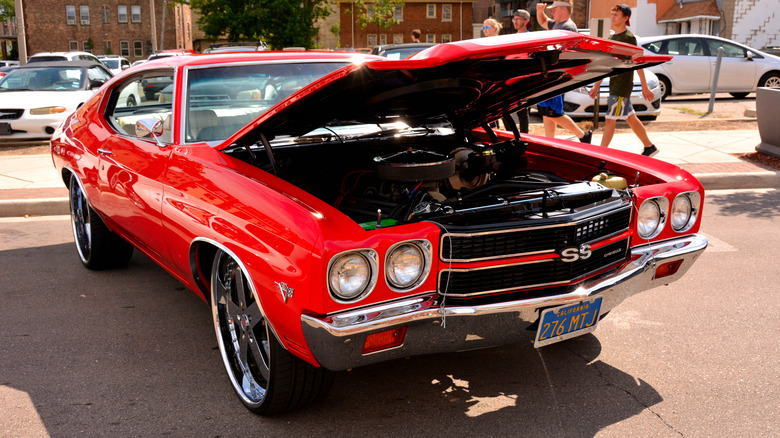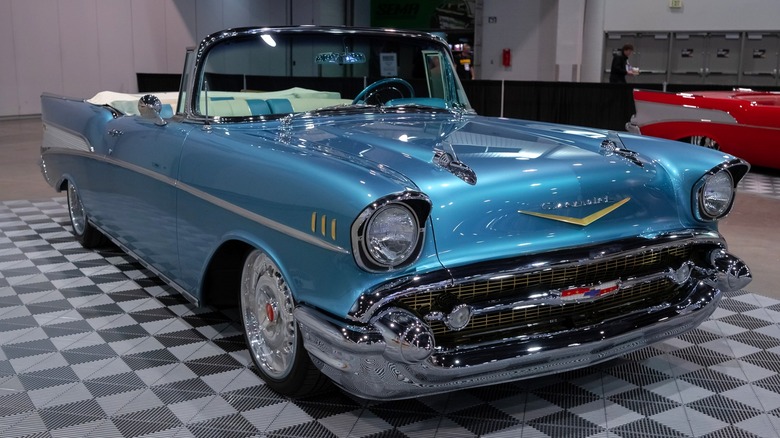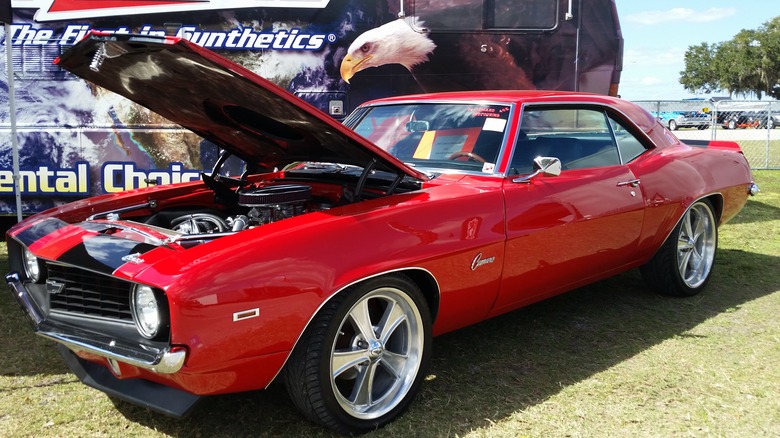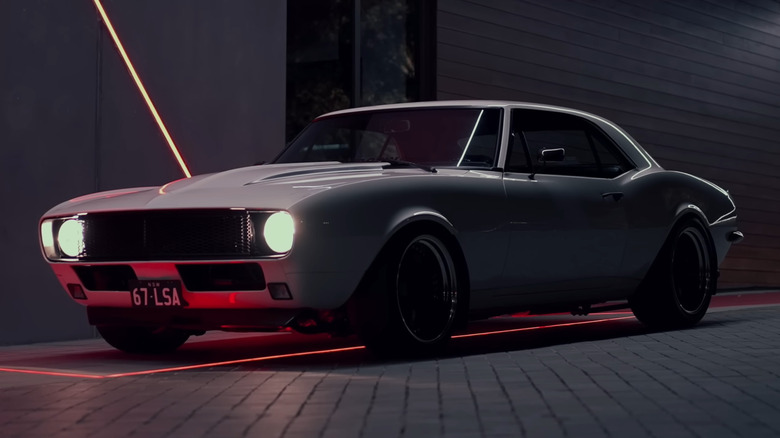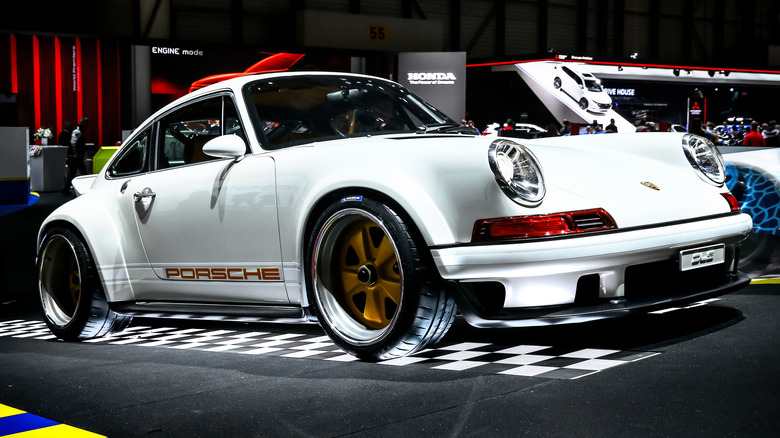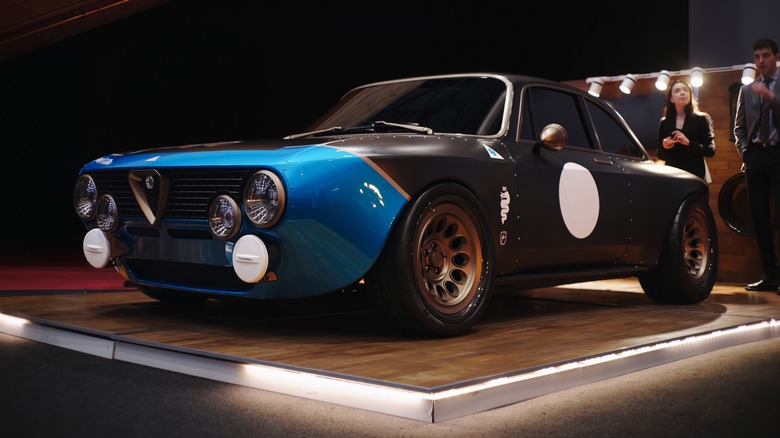Pro Touring Vs. Restomod: The Biggest Differences Between These Car Building Styles
Classic cars have an aura all of their own, with lines like the 1969 Ford Mustang having a signature style that sets them apart from even their sportiest, edgiest modern-day descendants. But while owning a classic big-block muscle car may seem like a great idea on paper, the reality may not be quite so rosy. Sure, it'll go fast in a straight line, but if you're used to modern cars you may find other aspects of the authentic vintage experience — overly-soft suspensions and sub-par braking systems, to name a couple — hard to live with.
That's where restomods and pro-touring restorations come into the picture. Both approaches aim to retain the old-school aesthetic appeal of a vintage car while bringing the driving experience up to the 21st century with modern upgrades and tweaks. They're not for purists who want that "blast from the past" feel of a vintage car, warts and all, but they're a great way to immerse yourself in the vibe of the '60s or '70s without all of the sacrifices of the original model.
If you want a modern experience with classic looks, then a restomod or pro-touring car is the way to go. But what do these terms mean, exactly, and how do you differentiate and choose between the two? Let's dive in.
What is a restomod?
The term "restomod" is a portmanteau of "restoration" and "modified," which explains the whole concept of a restomod remarkably well. They prioritize the restoration aspect, keeping a car close — or identical — to factory spec aesthetically while modifying it to improve the overall driving experience. However, restomods generally don't go too extreme with the modifications, retaining many of the qualities of the original car while bringing it up to modern-day standards.
How much work gets put into a restomod will vary depending on the original car and what the builder's goals are. However, most restomods tend to feature updated handling and safety features — modern brakes, power steering, updated suspension — and creature comforts like new interiors and infotainment systems. New powertrains are also quite common, especially the (in)famous LS swap — one of the most popular engine swaps for a classic car using General Motors' LS V8. Another common modification is new wheels and tires, with larger diameter and width almost always the order of the day.
The end goal of a restomod is to make a classic car more livable on a daily basis, bringing the reliability and drivability up to standards one would expect from a new, showroom-fresh car. It's a step beyond a traditional restoration, but isn't quite as extreme as a pro-touring car and its track-centric focus. Take a look at Singer's 911 restomods, such as the Octagon Commission, which has a traditional exterior married with a luxuriously updated interior and tuned engine.
What is pro touring?
Pro touring cars are a step beyond conventional restomods. While they start from the same principles of modernizing and updating a classic car, builders of pro-touring models — especially muscle cars — often have the express goal of outpacing a modern, high-performance counterpart in a straight line and around corners. As the "pro" in the name might suggest, pro-touring cars are generally competition-focused — they emphasize autocross and road circuit performance, albeit without entirely compromising on daily driver comforts.
This can involve a lot more work than a restomod as it requires modifications to most, if not all, aspects of the car to bring it up to a whole new level. Pro-touring cars can have all-new suspension setups with much lower ride heights and stiffer springs for better handling, paired with bigger wheels and sticky, high-performance tires. Engine and transmission upgrades are also par for the course, with some builds going so far as to use an entirely new chassis to take all that extra power and improve handling. Pro-touring cars can also feature modified bodies with new aerodynamics to further tweak the car's handling behavior — such as improving downforce for road courses.
The term "pro touring" dates back to the early 1990s and a modified 1969 Camaro that competed in the 1993 One Lap of America. The Camaro, known as "Tri-Tip," rocked a 400-cubic-inch small-block engine, Corvette ZR1 brakes, new 17-inch wheels, and weight-reducing parts such as a fiberglass hood. It set the template for — and kicked off — the whole pro-touring movement.
[Image by Michel Curi via Wikimedia Commons | Cropped and scaled | CC BY 2.0]
How are pro touring and restomod similar?
Both approaches focus on improving a classic car and go beyond simply restoring it to its old glory. In that regard, the two approaches are more similar than they are different. In fact, there is an argument to be made that "restomod" is a blanket term that covers pro touring as well. After all, both involve restoring a car before modifying it to suit whatever standards the owner wants — whether it's simply a classic car that can keep up with traffic and handle decently, or a track-focused monster capable of eating up Lamborghinis for lunch.
Restomod and pro-touring builders also modify similar parts of a car, just to differing degrees. Modified suspensions? Check. Improved brakes and steering? Present on restomods and pro-touring cars. Even modified (or entirely new) engines and transmissions aren't solely the domain of pro-touring models, with restomods often opting for upgraded powertrains. Witness the Volvo P1800 Cyan GT Restomod and its 2-liter, 300-400 horsepower engine, which is a far cry from the 100 horsepower its stock 1.8-liter engine produces.
If you boil the two terms down, they're more similar than they are different. But, as with so many things, it's the finer details that can help us separate the two.
What are the differences between pro touring and restomod?
Pro-touring and restomod cars may have a similar basic philosophy, but the two differ greatly in their end results. Restomods are often more faithful to the base model — their mods are meant to modernize without losing the spirit of the original. For instance, Singer's Dynamics and Lightweighting Study 911 makes many changes to the original, with a stiffer body and various tweaks to the powertrain and transmission. Despite these tweaks, the restomod retains the original's handling characteristics. Notably, Top Gear tested the vehicle and found that the 911 had all the over- and understeer traits of the original, just in a more manageable form. It's still recognizably a Porsche 911 from the early 1990s generation, but with power and grip levels elevated closer to that of a modern performance car.
Contrast that to a pro-touring build like Chris Smith's 1970 Camaro, which is an almost all-new car underneath the classic Chevrolet Camaro styling. Starting as an empty shell, Smith bolted on all-new front and rear suspension systems courtesy of Speedtech Performance, with Wilwood brakes all around. A 720-horsepower 427 LS7 engine sits underneath the hood, mated to a new sequential transmission. There's also a huge spoiler on the back, plus carbon fiber panels aplenty. The end result is a Camaro capable of navigating a small autocross circuit in a way that an original could only dream of.
How pro do you go?
If you're in the market for a modernized classic, the decision between a restomod and pro-touring build primarily comes down to what you want out of your car. If you're interested in a daily driver and want your car to retain an old-school feel without the old-school headaches, then a more conservative restomod is likely the way to go. On the other hand, if you're after pure performance and competitive racing, a pro-touring build might just be what the doctor ordered. It's really just a matter of degrees, and how extreme of a car you want.
Price comes into the picture, too, but the blurred line between pro-touring and restomods means it's hard to make a definitive statement about which of the two styles will be cheaper to build. Pro-touring cars can definitely cost a lot, and six-figure investments are not unheard-of — and probably quite common. But while restomods can be much cheaper, there are always exceptions. Some enthusiasts have put well over $100,000 into their restomods before selling them off for much less than what it cost them to build.
That final point is perhaps a saving grace: If you're happy buying instead of building, you can often buy restomods and pro-tourer cars for surprisingly affordable prices — at least, compared to what the builders spent. We've seen pro-touring cars boasting $100,000 worth of parts selling for less than $80,000. That's really a steal, provided you can live with someone else's parts choices.
